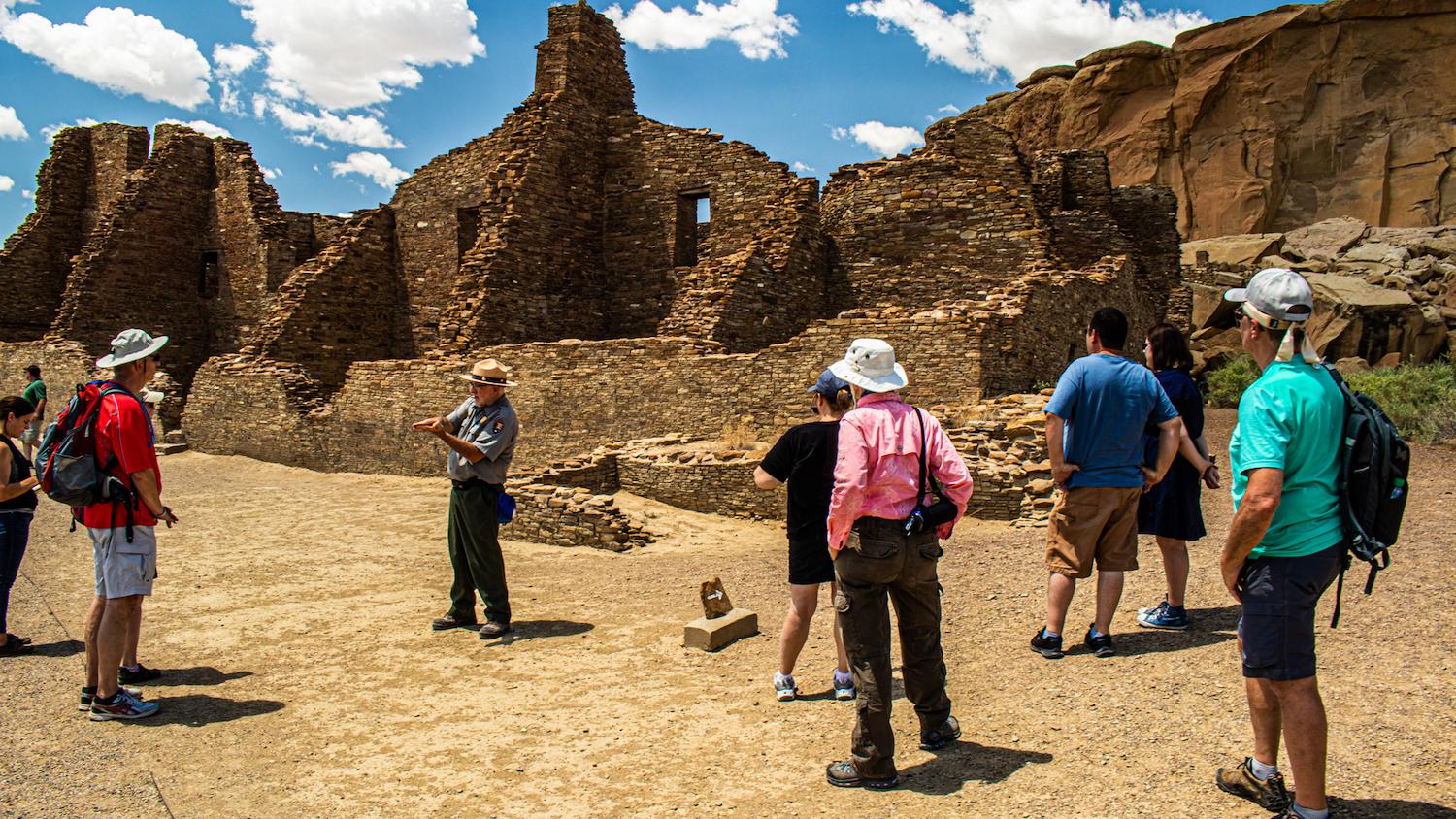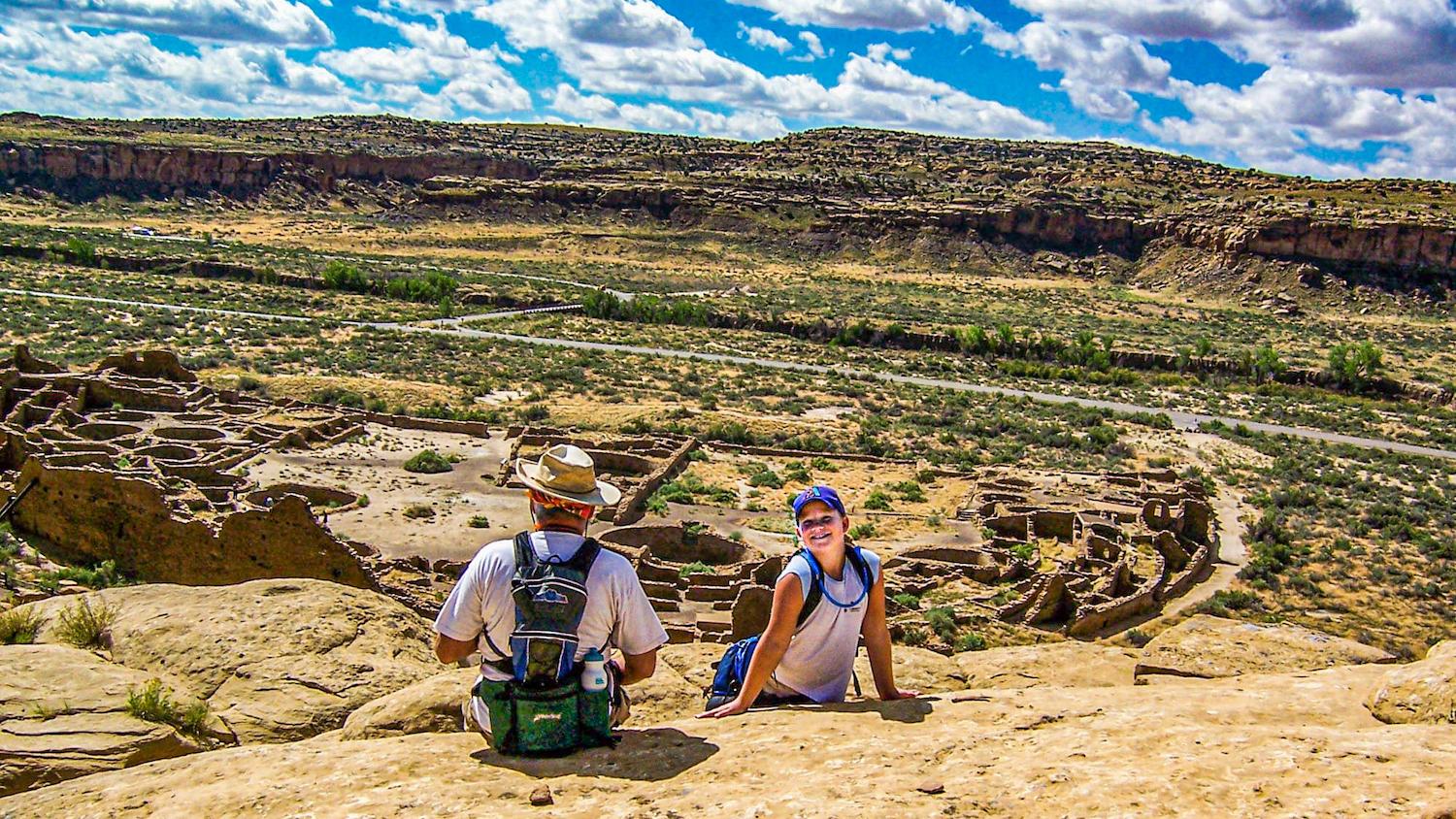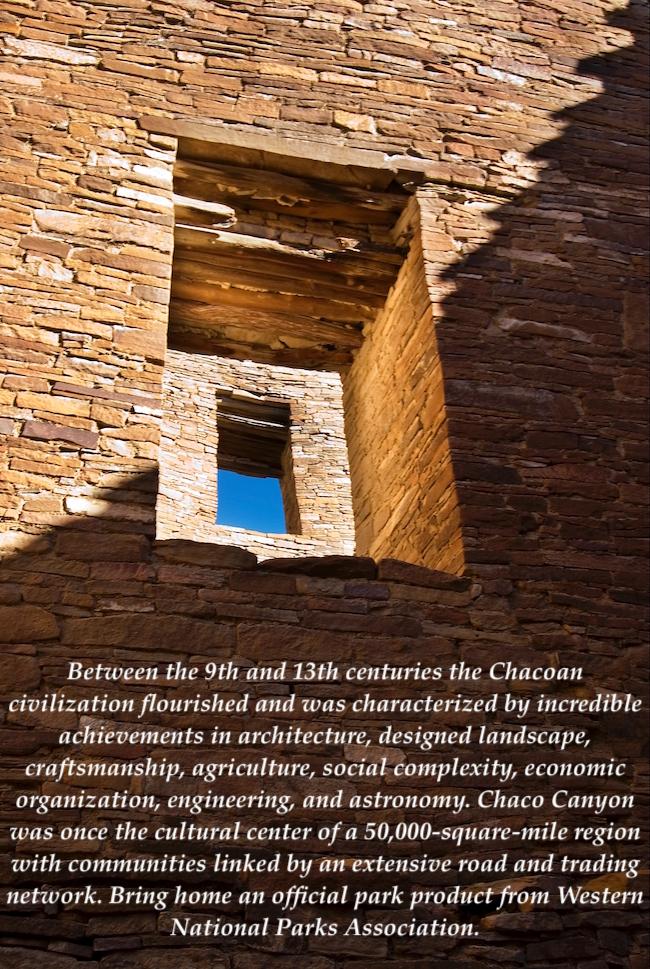
Fajada Butte at Chaco Culture National Historical Park/Eric Jay Toll
Chaco Culture National Historical Park: Hard To Reach, Filled With The Unexpected
By Eric Jay Toll
“It’s not like going to a national park,” said Matthew Campbell, on his second visit from his Albuquerque, New Mexico, home. “It’s a spiritual experience. It’s a different feeling.”
Chaco Culture National Historical Park is an atypical national park. The massive, thousand-year-old pueblos blend mysteriously into the towering canyon walls. Mystery and curiosity are among the top reasons thousands of visitors make the intentional trek far from paved roads deep into the Navajo Nation.
“I thought it was time for Edward to experience (Chaco Culture),” added Campbell.
Standing on the plaza at Hungo Pavi pueblo next to the large kiva, Matthew and Edward Donham-Stradling, also from Albuquerque, are astonished by the 150-room great house. Built nearly 1,000 years ago, Hungo Pavi is one of 16 such villages readily explored at Chaco Culture. The pueblo looks much as it did in 1847 when a U.S. Military survey team first visited the canyon.
Chaco is a national park people visit for more than scenery. Located between Crownpoint and Nageezi, Navajo Nation, New Mexico, it’s a trip visitors intend to make. In the Gallo Campground, the only accommodations within the park, it’s common for campers to be on their second or third visit.
“You feel very connected to the history here,” Campbell explained as a reason for his multiple trips. “More so than other parks. You stand here overwhelmed by the size of the ruins. It gets right into your soul. People should experience this. These are the size of modern apartments.”
Donham-Stradling grew up in Los Alamos, New Mexico. He said, “Living near Bandelier (National Monument), I had seen ruins, but nothing on the scale we see here at Chaco. I’ll be coming back again.”

One of the few national parks where visitors can wander through pueblos at their own paces, taking in a ranger-led tour of a village provides a full story and a chance to ask questions at Chaco Culture National Historical Park, between Crownpoint and Nageezi, Navajo Nation, New Mexico, U.S.
There is a special connection between Chaco Canyon and the people who visit.
“I read about Chaco Canyon, and it sounded interesting. We were making a western road trip from Wisconsin—I mean, everyone should take an American road trip,” Jeff Spalding spoke quietly with his northern English accent while finishing his dinner at their campsite. “So, we just showed up. There were people everywhere.”
“We arrived in the middle of the summer solstice celebration,” said his wife, Liz, picking up the story. The Spaldings made a temporary move to the United States in 1979 and never left. “We had no idea it was the solstice, let alone that there would be hundreds of people. That was 33 years ago today.”
Julia Beegles, their daughter, was a young child on that visit. “I don’t remember a whole lot, but I thought it was important to bring the kids this time,” she said, introducing Clara, 6, and Will, 3, and her husband, Kirby. The three-generations of campers are from Denver. “Will is about the age I was then, but Clara is quite fascinated.”
“We climbed all the way to the top of the cliff, two times,” she said, excitedly pointing up the meandering trail to the rim, about a 90-foot (27m) rise from the campground.
“We were so overwhelmed 33 years ago,” said Liz. “People were camping by the road, in the parking areas, everywhere. And the (Native Americans) in all their costumes were something just not forgotten.”

A father and daughter take in the site and smiles overlooking World Heritage Site, Pueblo Bonito, at Chaco Culture National Historical Park, between Nageezi and Crownpoint, Navajo Nation, New Mexico, U.S. Reaching the overlook requires a hike up the side of the Chaco Canyon North Mesa cliff, through a seam in the cliff face, and about 2 level mile (3.2km) hike/Eric Jay Toll
Each year on the solstices and equinoxes, Chaco Culture hosts representatives from dozens of indigenous tribes in ceremonial regalia to celebrate the seasonal changes. The Autumnal Equinox, September 20, is the return from the pandemic hiatus for traditional events.
Fajada Butte is the spiritual center of Chaco Canyon. The 380-foot-tall formation is in a near-perfect north-south/east-west alignment in the gap between the East and Chacra mesas. It is the site of the mysterious sun dagger. The Chacoans placed three upright 4.5-ton (2000kg) sandstone slabs near the top of the butte. Behind the slabs, they pecked a large spiral into the cliff face. On the summer and winter solstices, the rising sun paints daggers of light across the petroglyph.
During the ceremonies, the park opens access to the pueblos before sunrise, and the normally-off-limits great kiva at Casa Rinconada opens for the ceremonies. Navajo and descendants of the Ancestral Pueblos fill the day with traditional dance, song, and chant echoing through the canyon.
Some visit Chaco in a quest for science; some come for spirit and answers.
There are 20 kivas, the traditional round sanctuary of the ancient Puebloans, that appear to be randomly scattered across the plaza at Pueblo Bonito. Are they placed in random locations? One camper, Erica Ferg, Ph.D., is assistant professor of religious studies at Regis University, Denver. She was at Chaco to learn more about the religious culture in the canyon. Ferg postulated that the locations of the 20 round kivas in the Pueblo Bonito World Heritage Site are not random placements.
“The Chacoans were astronomers,” she said. “I think that the kivas are a match to constellations they would have seen.”
If visitors have only a day to spend in the park, they always come for the experience of Pueblo Bonito.
The more than 600-room village covers more than three acres (1.2ha), about four U.S. urban city blocks. Built by a people with no written language, metal tools, draught animals, nor the wheel, the pueblo stands four stories tall. Today’s entry is on top of the second level. Timber for the pueblo was carried from the Chuska Mountains, roughly 50 miles (80.5km) away over a developed road system.
The Chacoan road system extends hundreds of miles into Utah, Colorado, New Mexico and Arizona. The roads demonstrate that Chaco, rather than being in the middle of nowhere, was the center of trade, culture and astronomy. The paths are straight, include staircases and earthen ramps at cliff faces, and are 30-feet (9.1m) wide.
Some believe that the Chaco Pueblos, without a written language, could not build such massive structures unassisted. A few say that alien visitors helped the Chacoans build the great houses. Ferg, and park rangers, bristle at the notion.
“If aliens were directing the construction, the perspective of the stars would not be as seen from Earth,” she said. “They’d have guided the kiva placement based on the view from outer space.”

Hikers make their ways up the narrow stone staircase through a rock crevice to the canyon rim, around 200 feet (70m) above the floor. This is the start of three rim hikes. Once on top, the trails are generally level with minor elevation changes. Roundtrip, the overlook trail is 2 miles (3.2km), 1 hour, liter of water per person; Pueblo Alto complex, 3.2 miles (5.3km), 2 hours, 2 liters of water per person; Rim Trail loop, 5.4 miles (8.7km), 4 hours, 5 liters of water per person/Eric Jay Toll
This type of ongoing study and speculation brings the curious and the spiritual to Chaco Culture. Those making multiple visits over the years find that there are often new answers to old questions and a new understanding of old answers.
Many find deep emotions triggered during a visit to Chaco Culture. One ranger said he has seen people burst into tears during a Pueblo Bonito tour. People become overwhelmed, he explained. Chaco is an incredible experience. Some visitors react when learning that most Europeans lived in mud hovels while the Chacoans built this monumental village.
Safely visiting Chaco Culture National Historical Park
Chaco Culture National Historical Park is in the Navajo Nation about 90 minutes northeast of Crownpoint on New Mexico Route 57 South, or an hour west of Nageezi and U.S. 550 on Chaco Entrance Road. NM 57 is dirt, and Chaco Entrance Road is gravel. Both are passable in a carefully driven sedan. Obey the “do not enter when flooded” warning signs at wash crossings on both roads.
Climate and Geography
Chaco’s elevation is around 6,000 feet (1,828m), and there is essentially no natural shade on trails. The sun can be brutal even if the air temperature is moderately warm. Light-color, long sleeves are recommended. A sun hat and sunscreen are essential. When hiking – even wandering through the pueblos on the developed paths– drink one liter of water per hour per person. Coffee, iced tea, soda, beer do not hydrate. Drink a non-sugared electrolyte replacement for every three liters of water when actively hiking.
Chaco Canyon is hot and dry in the summer, often with violent afternoon wind-swept monsoons. The area is bitterly cold in winter, with temperatures well below freezing. The best time to visit is spring and early summer, and fall.
Accommodations
The only accommodation in the park is the Gallo Campground, which has more than 30 spaces. Recreation.gov handles the reservations. The campground has potable water, flush toilets, a kitchen wash area, but no showers. There are two group campsites. With no pull-through spaces, recreation vehicles are size-limited. More details are on the reservation website.
There are private campgrounds on Indian Route 9, about an hour south of the park and several options one- to two hours north of the park near Bloomfield. The nearest motels are in Bloomfield, about 90 minutes north on U.S. 550.
Eric Jay Toll is a travel writer and park explorer living in Phoenix, Arizona. He and his chocolate lab, Chaco, wander the parks, monuments and public lands of the American Southwest. He has been a visitor to Chaco Culture on eight previous visits. His work has appeared in USA Today Travel, RoadTrippers, Golf Digest, Desert USA, TravelingDad, and on travel websites and corporate websites.


Comments
Awesome article! I now have yet another destination goal!
I have visited Chaco many times and one of the highlights of each trip has been spending some time listening to the knowledge of a legendary Chaco ranger named G.B. Cornucopia.
Is he still there, or has he retired?
If he has, I hope he is doing well . . . but visitors now will never know how much they are missing.
The legendary G.B. Cornucopia is still at the park. He's talked about retiring, but hasn't taken any action to do so. He still leads the observatory, which was recently remodeled. On my first trip to Chaco in the 1990s, G.B. hosted a ranger talk at the Gallo Campground with a fire blazing and lighting the cliffs. He was still seasonal at that time and teaching high school in the Northwest. I've interviewed him once, and been to several of his archeoastronomy talks at the observatory at night.
Thank you for the good news,Eric.
I visited several years ago for the eclipse. I had no idea how this place still affects me. Amazing. I hope to return.
It really does get into your soul. This was my tenth trip since the mid-90s. I learn something new every trip. You should try to schedule a trip when there is no moon or close to no moon on a weekend to see stars from the observatory.
Me too